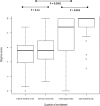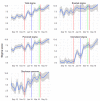Stigma and Ebola survivorship in Liberia: Results from a longitudinal cohort study
- PMID: 30485311
- PMCID: PMC6261413
- DOI: 10.1371/journal.pone.0206595
Stigma and Ebola survivorship in Liberia: Results from a longitudinal cohort study
Abstract
Background: Survivors of the 2014-2016 West Africa Ebola epidemic have been reported to suffer high levels of stigmatization after return to their communities. We sought to characterize the stigma encountered by a cohort of Ebola survivors in Liberia over time.
Methods: Ebola-related stigma was assessed from June 2015 to August 2017 in 299 adolescent and adult Liberian Ebola Survivor Cohort participants at three month intervals using adapted HIV stigma scales scored from 0 to 10 according to the proportion of answers indicating stigmatization.
Findings: The median time from Ebola Virus Disease (EVD) to study entry was 393 days (IQR 336-492). Participants (43% female) had a median age of 31 (IQR 25-40) years. Mean self-reported stigma levels were greater at baseline (6.28 ± 0.15 [IQR: 4.38-8.75]) compared to the first post-baseline visit (0.60 ± 0.10 [IQR: 0-0]; p<0.0001). During follow-up, stigma levels were stable. Baseline stigma significantly increased during enrollment and following clusters of Ebola re-emergence in Liberia. Survivors encountered primarily enacted and perceived external stigma rather than internalized stigma.
Conclusions: Ebola-related stigma was prevalent among Liberian survivors more than a year after EVD recovery. Self-reported stigma was greater in the period before cohort enrollment; however, some degree of stigmatization persisted years after EVD. Transient rises in stigma were observed following episodic Ebola re-emergence of EVD in Liberia. During future EVD outbreaks, enhanced public health interventions designed to prevent and mitigate Ebola-related stigma that is enacted and external should be implemented to support survivor recovery and community re-integration.
Conflict of interest statement
The authors have declared that no competing interests exist.
Figures




Similar articles
-
Ebola virus disease-related stigma among survivors declined in Liberia over an 18-month, post-outbreak period: An observational cohort study.PLoS Negl Trop Dis. 2019 Feb 27;13(2):e0007185. doi: 10.1371/journal.pntd.0007185. eCollection 2019 Feb. PLoS Negl Trop Dis. 2019. PMID: 30811388 Free PMC article.
-
An assessment of Ebola-related stigma and its association with informal healthcare utilisation among Ebola survivors in Sierra Leone: a cross-sectional study.BMC Public Health. 2020 Feb 5;20(1):182. doi: 10.1186/s12889-020-8279-7. BMC Public Health. 2020. PMID: 32020858 Free PMC article.
-
Reproductive health sequelae among women who survived Ebola virus disease in Liberia.Int J Gynaecol Obstet. 2019 Aug;146(2):212-217. doi: 10.1002/ijgo.12858. Epub 2019 Jun 14. Int J Gynaecol Obstet. 2019. PMID: 31074837 Free PMC article.
-
Post-Ebola psychosocial experiences and coping mechanisms among Ebola survivors: a systematic review.Trop Med Int Health. 2019 Jun;24(6):671-691. doi: 10.1111/tmi.13226. Epub 2019 Mar 20. Trop Med Int Health. 2019. PMID: 30843627
-
Addressing Ebola-related stigma: lessons learned from HIV/AIDS.Glob Health Action. 2014 Nov 7;7:26058. doi: 10.3402/gha.v7.26058. eCollection 2014. Glob Health Action. 2014. PMID: 25382685 Free PMC article. Review.
Cited by
-
Long-term physical and mental health outcomes of Ebola Virus Disease survivors in Kenema District, Sierra Leone: A cross-sectional survey.PLOS Glob Public Health. 2024 Nov 4;4(11):e0003421. doi: 10.1371/journal.pgph.0003421. eCollection 2024. PLOS Glob Public Health. 2024. PMID: 39495749 Free PMC article.
-
Stigma Experienced by Patients Who Recovered from COVID-19 in Post-Vaccination Period in Thailand; Prevalence and Associated Factors.Psychol Res Behav Manag. 2023 Sep 1;16:3561-3571. doi: 10.2147/PRBM.S425537. eCollection 2023. Psychol Res Behav Manag. 2023. PMID: 37675190 Free PMC article.
-
Predicting psychological service providers' empowerment in the light of the COVID-19 pandemic outbreak: A structural equation modelling analysis.Couns Psychother Res. 2020 Sep;20(3):406-418. doi: 10.1002/capr.12328. Epub 2020 Jun 14. Couns Psychother Res. 2020. PMID: 33162833 Free PMC article.
-
Systematic Review of Scales for Measuring Infectious Disease-Related Stigma.Emerg Infect Dis. 2024 Mar;30(3):519-529. doi: 10.3201/eid3003.230934. Emerg Infect Dis. 2024. PMID: 38407230 Free PMC article.
-
Interest in COVID-19 vaccine trials participation among young adults in China: Willingness, reasons for hesitancy, and demographic and psychosocial determinants.Prev Med Rep. 2021 Jun;22:101350. doi: 10.1016/j.pmedr.2021.101350. Epub 2021 Mar 12. Prev Med Rep. 2021. PMID: 33816087 Free PMC article.
References
-
- World Health Organization. Ebola Situation Report. 15 April 2015. Available from: http://apps.who.int/ebola/current-situation/ebola-situation-report-15-ap...
-
- Vetter P, Kaiser L, Schibler M, Ciglenecki I, Bausch DG. Sequelae of Ebola virus disease: the emergency within the emergency. Lancet Infect Dis 2016. June;16(6):e82–e91 10.1016/S1473-3099(16)00077-3 - DOI - PubMed
-
- Burki TK. Post-Ebola syndrome. Lancet Infect Dis 2016. July;16(7):780–781. 10.1016/S1473-3099(15)00259-5 - DOI - PubMed
-
- Van Bortel T, Basnayake A, Wurie F, Jambai M, Koroma AS, Muana AT, et al. Psychosocial effects of an Ebola outbreak at individual, community and international levels. Bull World Health Organ 2016. March 1;94(3):210–4. 10.2471/BLT.15.158543 - DOI - PMC - PubMed
-
- Hugo M, Declerck H, Fitzpatrick G, Severy N, Bamba-Moi Gababi M, Decroo T, et al. Post-Traumatic Stress Reactions in Ebola Virus Disease Survivors in Sierra Leone. Emerg Med Open Access [Internet] 2015. Available from: https://www.omicsonline.org/open-access/posttraumatic-stress-reactions-i...
Publication types
MeSH terms
Grants and funding
LinkOut - more resources
Full Text Sources
Medical

